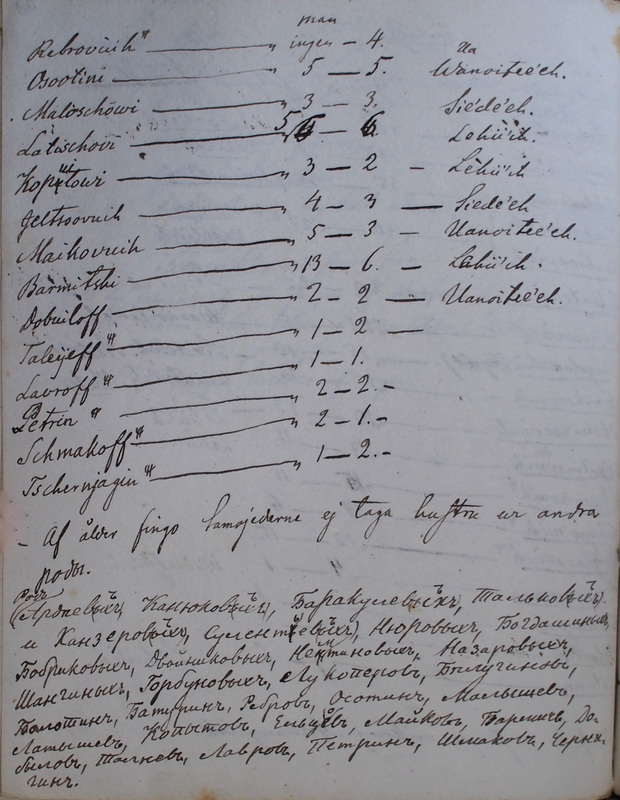Ethnographiska, historiska och statistiska anmärkningar. 236
Title
Ethnographiska, historiska och statistiska anmärkningar. 236
Description
|
Ryska Russian |
man |
qv[innor] |
[Samojediska] |
|
Rebrovùih
Rebrov
|
ingen |
4 |
|
|
Osootini
Osotyn – Вануйта. Ru Vanujta. Also Vanjuta, Vanojta. TN Ванойта, fe. Ванойʹ, Ванойтиʹ or Ванюта represents one of the six main branches of the European Nenets families. It has also been suggested to represent one of the exogamic groups of the Nenets, the other being Харючи. (Chomič 1976: 102–103; Dolgich 1970: 9–14; Tereščenko 2003: 41–42)
|
5 |
5 |
Ua/Wanoitee'eh |
|
Maloschōwi
Malošëv – Сядэй. Сядэй is, according to Dolgih, a subsection of the European Лэхэ. (Dolgich 1970: 9)
|
3 |
3 |
Sie'de'eh |
|
Latischovi
Латышëв – Лэхэ. Лэхэ is one of the biggest families of the European Nenets. (Chomič 1976: 103, 105)
|
5 |
6 |
Lehiì'ih |
|
Kopuitowi
Kopujtov – Лэхэ. Лэхэ is one of the biggest families of the European Nenets. (Chomič 1976: 103)
|
3 |
2 |
Lèhii'ih |
|
Jeltsoovuih
Elʹcëv – Сядэй. Сядэй is, according to Dolgih, a subsection of the European Лэхэ. (Dolgich 1970: 9)
|
4 |
3 |
Siede'eh |
|
Maikovuih
Majkov – Вануйта. Ru Vanujta. Also Vanjuta, Vanojta. TN Ванойта, fe. Ванойʹ, Ванойтиʹ or Ванюта represents one of the six main branches of the European Nenets families. It has also been suggested to represent one of the exogamic groups of the Nenets, the other being Харючи. (Chomič 1976: 102–103; Dolgich 1970: 9–14; Tereščenko 2003: 41–42)
|
5 |
3 |
Uanoitee'eh |
|
Barmitshi
Бармич – Лэхэ. Лэхэ is one of the biggest families of the European Nenets. (Chomič 1976: 102, 103)
|
13 |
6 |
Lehii'ih |
|
Dobuiloff
Бармич – Лэхэ. Лэхэ is one of the biggest families of the European Nenets. (Chomič 1976: 102, 103)
|
2 |
2 |
Uanoitee'eh |
|
Taleijeff #
Taleev. According to Chomič, the name goes back to Тысыя. See note [Тыссии].
|
1 |
2 |
|
|
Lavroff
#Lavrov
|
1 |
1 |
|
|
Petrin
#Petrin
|
2 |
2 |
|
|
Schmakoff #
Šmakov
|
2 |
1 |
|
|
Tscernjagin #
Černjagin
|
1 |
2 |
|
| Af ålder fingo Samojederne ej taga hustru ur
andra роды.
Most ethnographic sources note that the Nenets took their wives from outside their families, which is why it is most probable that a misunderstanding or writing error is behind this. See [page 252]. (Verbov 1939: 46–49; Chomič 1966: 142, 156–157).
|
Since the old days, Samoyeds have not been allowed to take a wife from different family group. |
| Роды: Ардеевыхъ /Ардеевъ, Канюковыхъ /Канюковъ, Баракулевыхъ /Баракулевъ, Тальковыхъ /Тальковъ и Ханзеровыхъ /Ханзеровъ, Сулентьевыхъ /Сулентьевъ, Нюровыхъ, Богдашиныхъ, Бобриковыхъ, Двойниковыхъ, Некмтановыхъ, Назаровыхъ, Шангиныхъ, Горбуновыхъ, Лукоперовъ, Белугиновъ, Болотинъ, Батуринъ, Ребровъ, Осотинъ, Малышевъ, Латышевъ, Копытовъ, Ельцеовъ, Майковъ, Бармичъ, Добы- ловъ, Талеевъ, Лавровъ, Петринъ, Шмаковъ, Черн- ягинъ. |
Family groups: Ardeev, Kanjukov, Barakulev, Talkov, and Chanzerov, Sulent'ev, Njurov, Bogdašin, Bobrikov, Dvojnikov, Mekmtanov, Nazarov, Šangin, Gorbunov, Lukoperov, Beluginov, Bolotin, Baturin, Rebrov, Osotin, Malyšev, Latyšev, Kopytov, El'ceev, Majkov, Barmič, Dobylov, Taleev, Lavrov, Petrin, Šmakov, Černjagin. |

